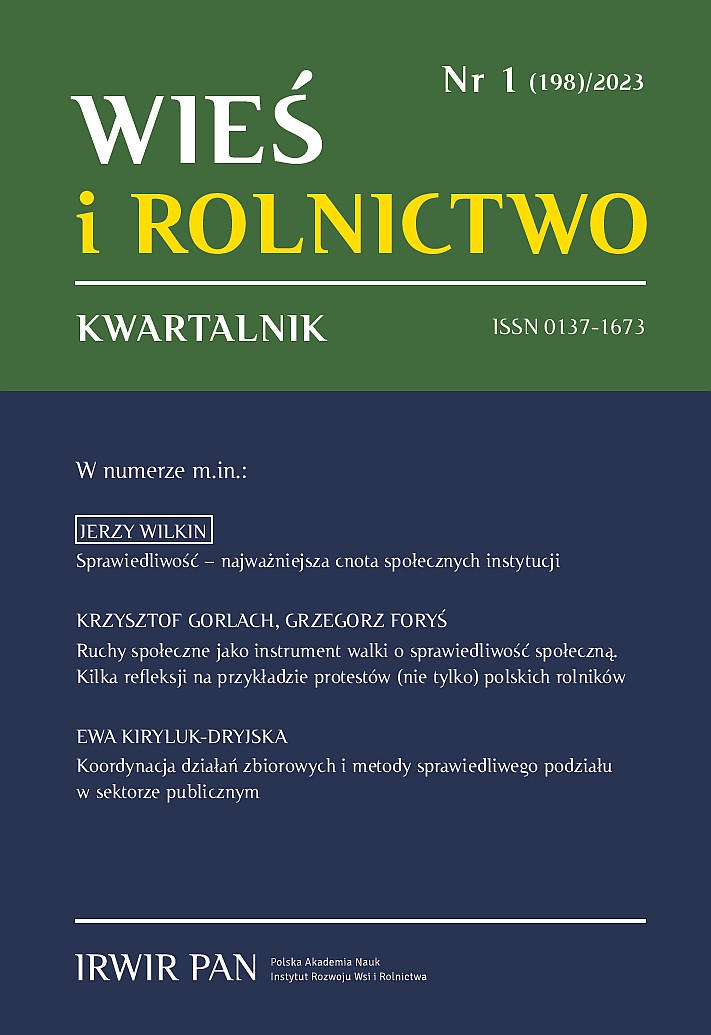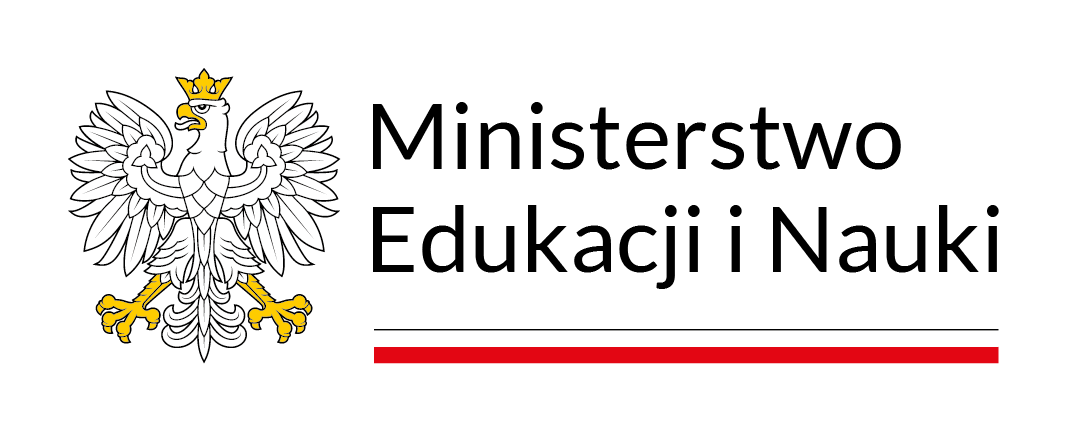Koordynacja działań zbiorowych i metody sprawiedliwego podziału w sektorze publicznym
DOI:
https://doi.org/10.53098/wir012023/04Słowa kluczowe:
sprawiedliwy podział, współpraca, ekonomia eksperymentalnaAbstrakt
Celem artykułu było zaprezentowanie teoretycznych podstaw problemu koordynacji działań zbiorowych oraz zaproponowanie metod sprawiedliwego podziału, które mogą być zastosowane do konstruowania budżetów polityki rolnej. W publikacji przedyskutowano wyniki badań eksperymentalnych nad skłonnością jednostek do kooperacji i podziałów sprawiedliwych, a następnie zaprezentowano możliwości zastosowania algorytmów sprawiedliwego podziału, które mają prowadzić do akceptowanych podziałów w praktyce wyboru publicznego. Wyniki badań wskazują, że osiągnięcie poczucia sprawiedliwości wymaga transparentności podziałów na podstawie jednoznacznie określonego wyboru kryteriów i metod.
Bibliografia
Axelrod R. (1984). The Evolution of Cooperation. New York: Basic Books.
Berg J., Dickhaut J., McCabe K. (1995). Trust, reciprocity and social history. Games and Economic Behaviour, 10 (1), 122–142. DOI: https://doi.org/10.1006/game.1995.1027
Blount S. (1995). When social outcomes aren’t fair: The effect of casual attributions on preferences. Organizational Behavior and Human Decision Process, 63 (2), 131–144. DOI: https://doi.org/10.1006/obhd.1995.1068
Bolton G.E., Brandts J., Ockenfels A. (2000). Fair procedures: Evidence from games involving lotteries. Economic Journal, 115 (506), 1054–1076. DOI: https://doi.org/10.1111/j.1468-0297.2005.01032.x
Brams S., Taylor A.D. (1996). Fair Division. From Cake-Cutting to Dispute Resolution. Cambridge–New York–Melbourne: Cambridge University Press. DOI: https://doi.org/10.1017/CBO9780511598975
Bui T.X., Jarke M. (1986). Communications design for co-op: A group decision support system. ACM Transactions on Information Systems, 4 (2), 81–103. DOI: https://doi.org/10.1145/6168.6169
Chaudhuri A. (2009). Experiments in Economics: Playing Fair with Money. Abingdon, Oxfordshire: Routledge.
Cohler Y.J., Lai J.K., Parkes D.C., Procaccia A. (2011). Optimal envy-free cake cutting. W: Proceedings of the 25th AAAI Conference on Artificial Intelligence (s. 626–631). Palo Alto, C.A: AAAI. DOI: https://doi.org/10.1609/aaai.v25i1.7874
Degefu D.M., He W., Yuan L., Zhao J.H. (2016). Water allocation in transboundary river basins under water scarcity: A cooperative bargaining approach. Water Resources Management, 30 (12), 4451–4466. DOI: https://doi.org/10.1007/s11269-016-1431-6
Engel C. (2011). Dictator games: A meta study. Experimental Economics, 14 (94), 583–610. DOI: https://doi.org/10.1007/s10683-011-9283-7
Fehr E., Gächter S. (2000). Cooperation and punishment in public goods experiments. American Economic Review, 90 (4), 980–994. DOI: https://doi.org/10.1257/aer.90.4.980
Fleurbaey M., Salles M., Weymark J.A. (red.) (2008). Justice, Political Liberalism, and Utilitarianism: Themes from Harsanui and Rawls. Cambridge: Cambridge University Press. DOI: https://doi.org/10.1017/CBO9780511619595
Forsythe R., Horowitz J.L., Savin N.E., Sefton M. (1994). Fairness in simple bargaining experiments. Games and Economic Behavior, 6 (3), 347–369. DOI: https://doi.org/10.1006/game.1994.1021
Fragnelli V., Kiryluk-Dryjska E. (2019). Rationing methods for allocating the European Union’s Rural Development Funds in Poland. Economia Politica, 36 (1), 295–322. DOI: https://doi.org/10.1007/s40888-018-00140-6
Gordon-Hecker T., Choshen-Hillel S., Shalvi S., Berby-Meyer Y. (2017). Resource allocation decisions: When do we sacrifice efficiency in the name of equity? W: M. Li, D.P. Tracer (red.). Interdisciplinary Perspectives on Fairness, Equity and Justice (s. 93–105). New York: Springer International Publishing. DOI: https://doi.org/10.1007/978-3-319-58993-0_6
Güth W., Schmittberger R., Schwarze B. (1982). An experimental analysis of ultimatum bargaining. Journal of Economic Behavior and Organization, 3 (4), 367–388. DOI: https://doi.org/10.1016/0167-2681(82)90011-7
Kampas A., White B. (2003). Selecting permit allocation rules for agricultural pollution control: A bargaining solution. Ecological Economics, 47 (2–3), 135–147. DOI: https://doi.org/10.1016/S0921-8009(03)00195-2
Kirschke D., Jechlitschka K. (2003). Interaktive Programmierungsansätze für die Gestaltung von Agrar- und Umweltprogrammen. Agrarwirtschaft, 52 (4), 1–7.
Kirschke D., Jechlitschka K. (2002). Angewandte Mikroökonomik und Wirtschaftspolitik mit Excel. München: Verlag Vahlen.
Kiryluk-Dryjska E. (2019). Sprawiedliwy podział. Kryteria, metody i aplikacje. Warszawa: Wydawnictwo Naukowe PWN.
Kiryluk-Dryjska E. (2014a). Fair division approach for the European Union’s structural policy budget allocation: An application study. Group Decision and Negotiations, 23 (3), 597–615. DOI: https://doi.org/10.1007/s10726-013-9346-6
Kiryluk-Dryjska E. (2014b). Alokacja środków finansowych na wybrane działania PROW 2014–2020 z wykorzystaniem optymalizacji liniowej. Journal of Agribusiness and Rural Development, 3 (33), 61–73.
Kiryluk-Dryjska E., Beba P. (2018). Region-specific budgeting of rural development funds: An application study. Land Use Policy, 77, 126–134. DOI: https://doi.org/10.1016/j.landusepol.2018.05.029
Linder C., Rothe J. (2016). Cake-cutting: Fair division of divisible goods. W: J. Rothe (red.). Economics and Computation: An Introduction to Algorithmic Game Theory, Computational Social Choice, and Fair Division. Berlin–Heidelberg: Springer. DOI: https://doi.org/10.1007/978-3-662-47904-9
Lissowski G. (2008). Zasady sprawiedliwego podziału dóbr. Warszawa: Wydawnictwo Naukowe Scholar.
Madani K., Zarezadeh M., Morid S. (2014). A new framework for resolving conflicts over transboundary rivers using bankruptcy methods. Hydrology and Earth System Sciences, 18 (8), 3055–3068. DOI: https://doi.org/10.5194/hess-18-3055-2014
Matsatsinis N.F., Samaras A.P. (2001). MCDA and preference disaggregation in group decision support systems. European Journal of Operational Research, 130 (2), 414–429. DOI: https://doi.org/10.1016/S0377-2217(00)00038-2
Mianabadi H., Mostert E., Pande S., van de Giesen N. (2015). Weighted bankruptcy rules and transboundary water resources allocation. Water Resources Management, 29 (7), 2303–2321. DOI: https://doi.org/10.1007/s11269-015-0942-x
Mianabadi H., Mostert E., Zarghami M., van de Giesen N. (2014). A new bankruptcy method for conflict resolution in water resources allocation. Journal of Environmental Management, 144 (1), 152–159. DOI: https://doi.org/10.1016/j.jenvman.2014.05.018
Munda G. (2004). Social multi-criteria evaluation: Methodological foundations and operational consequences. European Journal of Operational Research, 158 (3), 662–677. DOI: https://doi.org/10.1016/S0377-2217(03)00369-2
Noё R., Hammerstein P. (1994). Biological markets: Supply and demand determine the effect of partner choice in cooperation, mutualism and mating. Behavioral Ecology and Sociobiology, 35 (1), 1–11. DOI: https://doi.org/10.1007/s002650050063
Olson M. (1965). The Logic of Collective Action. Cambridge, Mass.: Harvard University Press. DOI: https://doi.org/10.4159/9780674041660
Petrosjan L., Zaccour G. (2003). Time-consistent Shapley value allocation of pollution cost reduction. Journal of Economic Dynamics and Control, 27 (3), 381–398. DOI: https://doi.org/10.1016/S0165-1889(01)00053-7
Plottu B., Plottu E. (2011). Participatory evaluation: The virtues for public governance, the constraints on implementation. Group Decision and Negotiation, 20 (6), 805–824. DOI: https://doi.org/10.1007/s10726-010-9212-8
Procaccia A. (2016). Cake cutting algorithms. W: F. Brandt, V. Conitzer, U. Endriss, J. Lang, A. Procaccia (red.). Handbook of Computational Social Choice (s. 311–330). Cambridge: Cambridge University Press. DOI: https://doi.org/10.1017/CBO9781107446984.014
Rabin M. (1993). Incorporating fairness into game theory and economics. American Economic Review, 83 (5), 1281–1302.
Roth A.E., Prasnikir V., Okuno-Fujiwara M.I., Zamir S. (1991). Bargaining and market behavior in Jerusalem, Ljubljana, Pittsburg and Tokyo: An experimental study. American Economic Review, 81 (5), 1068–1095.
Solís-Baltodano M.-J., Giménez-Gómez J.-M., Peris J.-E. (2022). Distributing the European structural and investment funds from a conflicting claims approach. Review of Regional Research, 42, 23–47. DOI: https://doi.org/10.1007/s10037-021-00164-9
Vavra P., van Beer J., Sanfey A. (2017). The neural basis of fairness. W: M. Li, D.P. Tracer (red.). Interdisciplinary Perspectives on Fairness, Equity and Justice (s. 9–31). New York: Springer International Publishing. DOI: https://doi.org/10.1007/978-3-319-58993-0_2
Williams G. (1966). Adaptation and Natural Selection. Princeton NJ: Princeton University Press.
Woodruff P. (2011). The Ajax Dilemma: Justice, Fairness, and Rewards. Oxford: Oxford University Press. DOI: https://doi.org/10.1093/acprof:osobl/9780199768615.001.0001
Yu S., Wei Y.-M., Wang K. (2014). Provincial allocation of carbon emission reduction targets in China: An approach based on improved fuzzy cluster and Shapley value decomposition. Energy Policy, 66, 630–644. DOI: https://doi.org/10.1016/j.enpol.2013.11.025
Zhang Y.-J., Wang A.-O., Da Y.-B. (2014). Regional allocation of carbon emission quotas in China: Evidence from the Shapley value method. Energy Policy, 74, 454–464. DOI: https://doi.org/10.1016/j.enpol.2014.08.006











